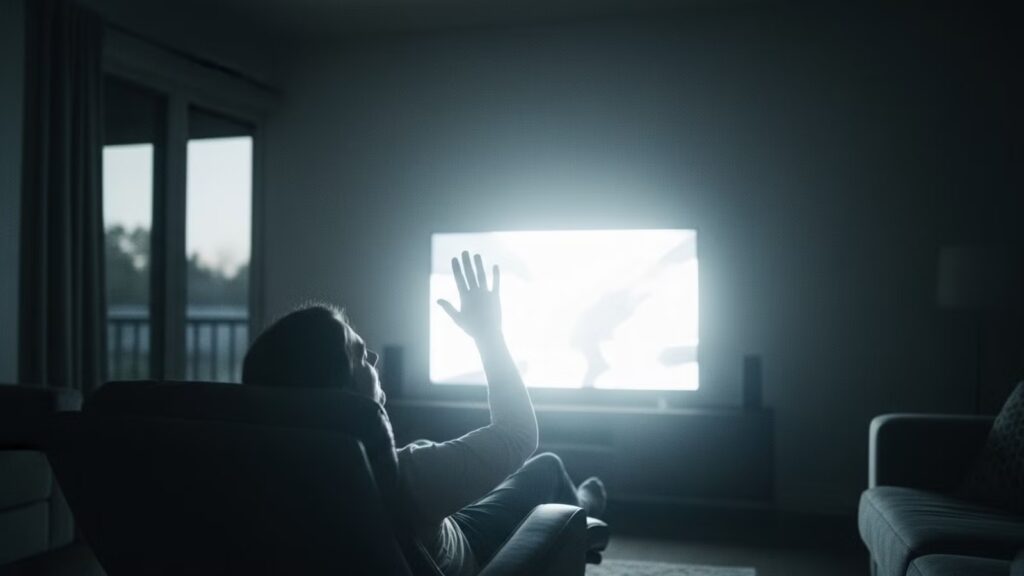TVs are getting brighter and brighter, and in general that’s a good thing. A brighter image is usually more pleasing to the eye, and in bright rooms it makes TVs easier to watch.
However, somewhat ironically, there’s a dark side to TV brightness. Apart from potentially having more brightness on tap than we need, running your TV brightness too high can lead to an early demise for your prized panel.
Why Brightness Isn’t Always Better
High brightness in a TV is a prized specification. We look for excellent peak brightness to get the most out of HDR. Though usually this just matters for small parts of the screen, such as the core of a flame or a flash of lightning. Overall brightness (an area where OLEDs have traditionally struggled) is why LCD TVs with LED backlights seem so colorful and vibrant. Brightness is especially important for a TV to be easily visible in a bright room, such as a lounge with the curtains drawn open.
Credit: Sydney Louw Butler/How-To Geek
There’s a reason that TVs used to ship with something called “torch mode”, which was an intended setting for the showroom floor. The brightest TVs would wow people the most in the store, only for them to be turned down when they got home.
In fact, if you didn’t know about said torch mode and left the TV with its brightness cranked up all the way, you’d face the triple threat of higher power consumption, accelerated TV wear, and excess heat. But, how exactly does high brightness kill your TV? That depends on the specific type of TV you have.
LCD/LED Panels: Edge-Lit vs. Direct-Lit, Full-Array, and Mini-LED Backlights
Credit: Sydney Louw Butler / How-To Geek
Increased heat will degrade LEDs and make them fail, but the problem is different depending on what type of LED backlight your LCD TV uses. The worst offenders are edge-lit LED LCDs, which have all of their LEDs on one side of the screen, and then use a diffuser to spread the light (usually unevenly) across the panel. The big advantage of edge-lit screens is that they can be thinner than other types of LCD, but the downsides are many.
In particular, RTINGS found that edge-lit TVs failed significantly faster in their big torture test.
Since the LEDs have to run brighter, and are all concentrated in one spot, they tend to get hotter than the boiling point of water at max brightness. This does everything from making the LEDs fail, to melting and splitting the light diffuser.
LED LCDs that are directly lit, whether old-school, full-array, or mini-LED, don’t fail as quickly or as dramatically, but the same general principle applies. If you have a TV with dimming zones, those zones that are hammered the hardest can fail first, leaving you with dead spots on your screen.
OLED Panels: Organic Pixels With a Shorter Fuse
Credit: Tim Rattray / How-To Geek
OLEDs (Organic Light-Emitting Diodes) don’t have a backlight at all, which is one of the major advantages of the technology. Every pixel emits its own light, making this panel technology capable of inky blacks and frankly the best image quality of any current screen technology you can buy.
However, OLEDs are fragile and prone to issues like permanent image retention or “burn-in”. However, what burn-in actually is might surprise you, because it’s really just a difference in the state of wear in different pixels. This is why if you have an image like a newscast on your OLED for a long time, things like the logo and lower-thirds make a permanent impression as those pixels lose their brightness and color at a different rate.
Modern OLEDs have mitigations, such as a compensation cycle, which levels out that wear by adjusting the voltages individual pixels get. However, OLED pixels will fade and lose their vibrance over time regardless, and the brighter you run your TV the faster this happens. While you won’t get sudden failure as with an LED backlight, running at max brightness will wear your OLED out faster. What makes this worse is that most OLEDs out there, excluding the latest generation of panels, aren’t particularly bright to begin with. So here there’s actually an incentive to crank the brightness slider up.
How to Protect Your TV Without Sacrificing Picture Quality
As a general rule, you don’t want to set your TV’s brightness to 100 or 90 percent and just leave it there. Instead, if your TV has adaptive brightness technology that can sense the ambient brightness, turn that on. So it’s nice and viewable during the day, but as the light level drops, it adjusts to it to maintain the same perceived brightness.
You also have control over the light levels in the room, so you may want to darken the room instead of raising the brightness on your TV. Personally, on a TV with a peak brightness of around 1000 nits, I find that between 30–70 percent brightness works best for me. Any brighter and it actually hurts my eyes. But you need to use your own judgment.
Also, when you next buy a TV, consider a model with a total brightness level that’s above what you need. So that you can run it at half-brightness and still get all the brightness you wanted in the first place.
7/10
Brand
TCL
Display Size
85-inches
Dimensions
74 x 42 x 2.3 (without stand)
Operating System
Google TV

